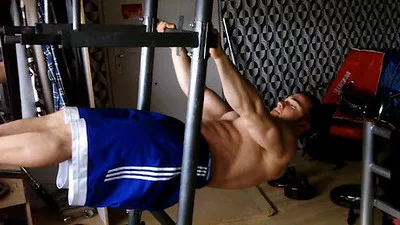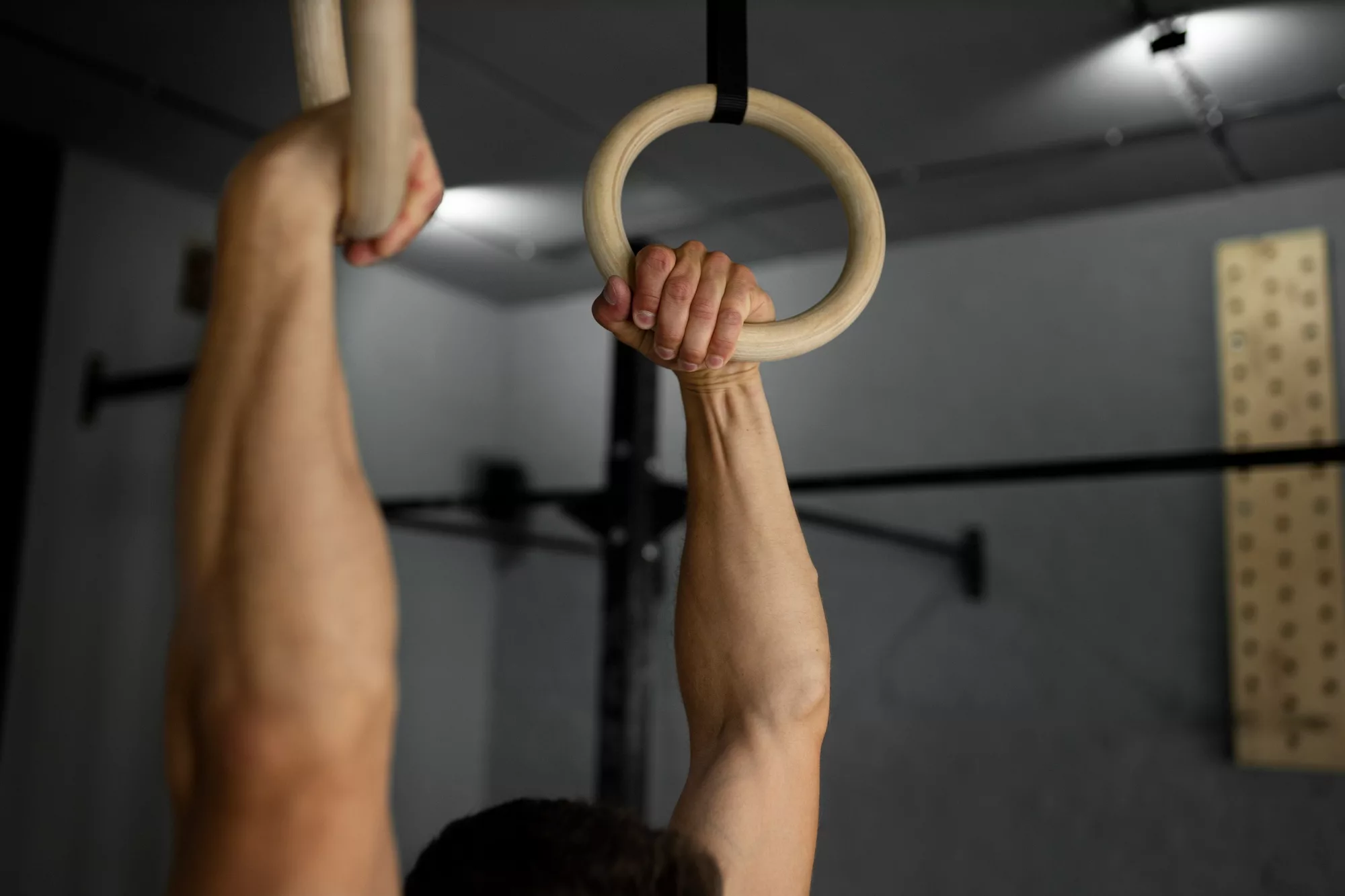That Annoying “Weird” Pain We All Know Too Well.
You’ve just finished a front lever session.
Your lats? Barely tickled.
Your core? Meh.
But your elbows? Your shoulders?
They feel like they’ve just walked out of a bar fight between circus acrobats and steroid-loaded powerlifters.
It’s that kind of discomfort that doesn’t feel muscular.
It’s more “internal.”
Deeper.
The kind of feeling that makes you think: “I must be doing something wrong… but I have no idea what.”
And if it helps, we’ve all been there.
Even the people doing planches while sipping espresso.
Straight arms aren’t about isolation — they’re about surviving leverage

When you train skills like the front lever, planche, back lever, maltese, or even just a static support on the bars...
You’re not working in a friendly environment.
You’re putting your joints in a biomechanically awkward position, under insane loads, and asking them to “hold” isometrically.
Put simply?
The lever destroys you.
Because the longer the arm, the farther the weight shifts from the joint.
And that creates a lovely torque that lands straight on your joints.
And if you’re not properly activating the muscles that are supposed to resist that force?
Good luck to your tendons and joint capsules.
Your muscles should do the work — but if you can’t feel them, they probably aren’t
That’s the whole problem.
In theory, during a front lever, you should feel fire and fury in your lats, lower scapula area, and core.
In practice?
If all you feel is elbows, shoulders, and maybe even your wrists…
Then it’s not your muscles holding you up.
You’re relying on passive structures.
Like:
- Tricep and bicep tendons
- Shoulder capsule
- Ligaments
- Articular cartilage (if things go really wrong)
This often happens when:
- You don’t have good scapular awareness yet
- You lock your arms without “activating” the muscles around them
- You’re forcing a skill your body isn’t ready for
And this isn’t about “being strong.”
It’s about being biomechanically ready.
Having control.
Being able to activate the right muscles, the right way, at the right time.
The anatomical backstory (for those who really want to understand)
During a front lever, you’re asking your shoulders to stay extended, your scapulae to stay depressed and retracted, and your elbows not to snap.
All while your center of gravity desperately wants to fall.
If your scapulae aren’t active, or if your nervous system can’t effectively recruit your lats, long head of the triceps, and deep core in that context…
Guess who takes all the load?
The tissues that shouldn’t.
It’s like trying to hang a chandelier from the ceiling using tape instead of hooks.
It might work for a second.
Then everything crashes.
The most common mistake: thinking straight arm = locked arm
A lot of people — myself included in the beginning — make the mistake of “locking up.”
They straighten the arm, clamp the elbow, freeze the joint.
And think: “Now I’m more stable.”
Huge mistake.
Because when you lock the arm passively, you’re taking the muscles out of the game.
It’s like turning off the engine and letting your car coast downhill in neutral.
That’s why we have the concept of active straight-arm strength.
It means yes, the arm is extended…
But it’s the muscle keeping it extended. Not passive locking.
And that makes all the difference.
How to stop feeling just joint pain: practical tips from someone who’s been there
Progressions That Actually Protect You
If you keep jumping straight into full positions just because your body “can sort of do it,” you’re playing with fire.
What saved my elbows, shoulders, and wrists?
Serious progressions, with no shortcuts.
Start with tuck.
Then advanced tuck.
Then straddle.
Each step teaches your joints how to handle load, builds connective tissue resilience, and helps your brain map the position safely.
Skipping steps just fast-tracks you to inflammation.
Double down on the slow route.
It’s faster in the long run.
Active Scapular Control Everywhere
You can’t afford to be passive in any position.
When you’re holding something — a tuck, a lever, even just hanging — you need to activate.
Don’t just “be there.”
Pull the scapulae down and in.
Push the floor away.
Resist gravity.
Learn what scapular retraction and depression feel like — and then repeat that control in isometric holds, mobility drills, and core work.
Every position becomes safer when your scapulae are doing their job.
Controlled Eccentrics: The Secret Weapon
If you want true strength — not just flashy shapes — you need to control the descent.
Lowering yourself slowly from a hard position builds more than just muscle.
It builds awareness.
It teaches you how to own the position, not just reach it.
That’s where real resilience grows.
Mobility Alone Isn’t the Fix (But It Helps)
Yes, you need shoulder and thoracic mobility.
If your chest and upper back are locked, you’re not going to activate well — period.
Stretch, breathe, mobilize.
But don’t make the mistake of thinking mobility alone protects your joints.
That’s only half the puzzle.
Mobility Without Stability = Silent Pain
Here’s the hard truth:
You might be mobile… but still unstable.
And that’s when pain creeps in.
Just because you can lift your arms like a ballerina doesn’t mean your joints are safe under load.
If you can’t hold that position actively — with control and tension — it’s useless.
That’s where neuromuscular control comes in.
You need to train your body to stay strong at the end of the range, not just reach it.
Exercises That Force You to Be Stable
Here’s what made a difference for me:
- Y-holds on an incline bench (for end-range posterior chain tension)
- Planche lean regressions with locked scapulae
- Slow eccentrics from tucked positions
All of these make your body fight for control.
Not just flexibility.
But the kind of tension that protects your joints when it matters.
Mobility + active stability = joint-friendly strength.
Anything less = pain waiting to happen.
Don’t confuse pain with progress
For way too long, I thought that if something hurt, it meant I was growing.
Like: “If it hurts, it means I’m pushing hard!”
But nope.
If every time you do straight-arm work your joints are screaming, you’re not building strength.
You’re building trauma tolerance.
And guess what? That won’t last.
The body breaks before it gets strong.
Watch out for invisible loads: how heavy is your body really in a lever?
Many underestimate the fact that during a skill like the front lever or planche, you’re not just “holding” your weight.
You’re multiplying the perceived load.
In a full planche, for example, the force your shoulders must resist can reach 2x your body weight, depending on lever, angle, and your structure.
And that’s not all: the farther your center of gravity goes, the worse the lever arm becomes.
Translation: even if you weigh 70 kg, the joint load can feel like 130–140 kg of actual effort on your shoulders and elbows.
That’s why people who train “by feel” alone often end up overloading without realizing it.
The solution?
Learn to estimate internal mechanical load, not just external weight.
Set smart volume rules, with real rest and deload weeks built into your plan.
Wrong breathing can sabotage your internal tension
One of the most overlooked details in straight-arm training is how you breathe while holding position.
Most people make this mistake: They hold their breath.
They trap air inside to “brace” the position, thinking they’ll be stronger.
But holding your breath creates disorganized internal pressure:
- Your core stiffens passively
- Deep muscles don’t activate properly
- Tension ends up dumping where it shouldn’t
The result?
Muscles disconnect, and joints take the hit.
Better to use active diaphragmatic breathing:
Light inhale before lifting,
Slow exhale while holding,
Maintain core tension without clenching everything.
A tiny detail — but it can save your entire set.
Isometric skills and neural fatigue: the role of your central nervous system
When you hold a straight-arm position, the first thing to tire isn’t the muscle.
It’s your brain.
Or more accurately, your central nervous system.
Training isometric skills under tension requires massive, continuous neural output.
There’s no momentum.
No concentric or eccentric phase to “offload.”
Just nonstop effort.
That’s why even if your body feels okay, after 2–3 attempts you crash.
You’re not weak.
You’re neurologically spent.
The solution?
- Give your CNS time to recover (3–4 real minutes of rest)
- Don’t overdo frequency (3x a week is enough)
- Alternate straight-arm skills with more dynamic or pump-focused work
That way, you avoid burnout and improve quality, not just quantity.
Real strength is built when you can repeat the move without breaking down
Straight-arm skills are mesmerizing.
They’re athletic, pure, elegant.
But they require patience, control, intelligent tension.
They’re not an ego contest.
They’re a challenge in biomechanical precision.
If you train your joints, you stall.
If you train your muscles the right way, you grow.
And trust me — the feeling of a clean front lever, where your lats scream and your elbows feel happy, is priceless.
Start from there. Don’t force it. But don’t avoid it either.
Feel where you’re failing.
Slow down.
Correct.
Activate.
Then get back out there.
Because your body, if you listen, knows what to do.
And your elbows, eventually, will stop hating you.


